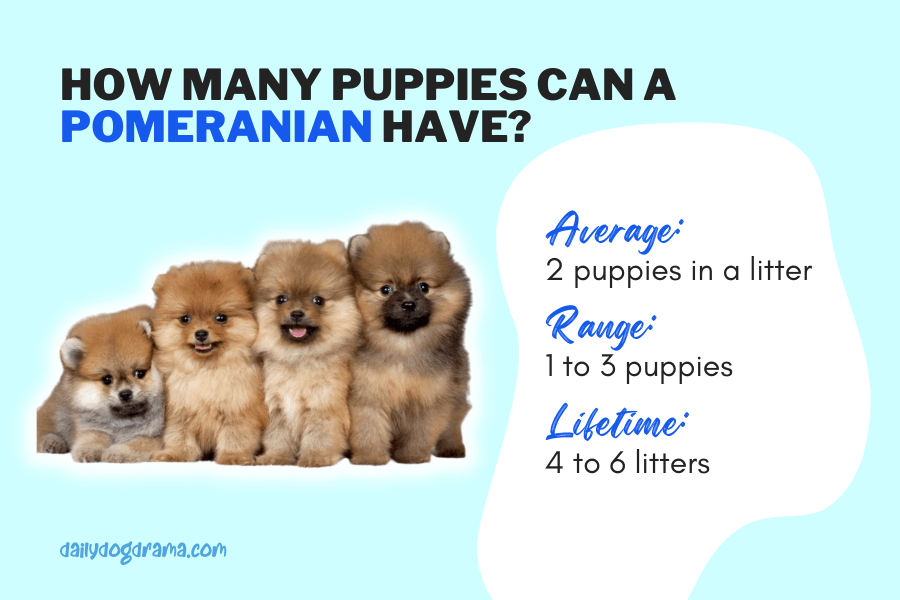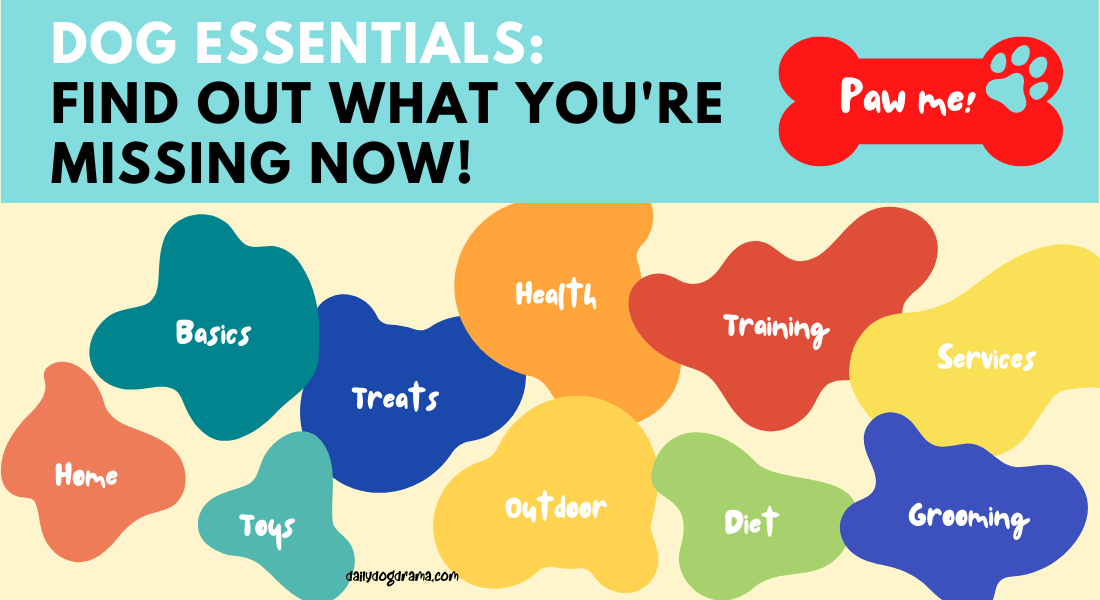Do you know what DOG ESSENTIALS you are missing out? Find out now!
Zack Keithy, our author, is a certified veterinarian technician (UC Blue Ash) for over 6 years (contact him here). The articles written here are based on his expertise and experience, combined with a review by our expert vet reviewers including Dr M. Tarantino. Learn more about us here.
Pomeranians are small, fluffy dogs that have been a favorite pet since the early 1900s. They are known for their highly energetic personality, but they also make great companions.
And if you own one, or if you’re thinking about getting one as a pet, you may be wondering, just how many puppies can a Pomeranian have?
The average litter size for a Pomeranian is between 1 and 3 puppies, common for a small dog breed. Most of them give birth naturally without complications, and in some rare cases, you might even see up to 6 puppies in a litter. Various factors such as age and health will influence this.
In this post, we shall look into the numbers a bit more in detail, talk about the factors that can influence litter sizes, and handling a Pom pregnancy.
Medical Questions? Talk to a Veterinarian 24/7.
Connect one-on-one with a licensed vet who will answer your questions in minutes.
*Article may contain affiliate links to retailers like Amazon and Chewy. Learn more on our disclosure page.

- Pomeranian Reproduction Basics
- How Many Puppies Can a Pomeranian Have in One Litter?
- How Big Is a Pomeranian Puppy at Birth?
- How Many Healthy Litters Can a Pomeranian Have in Their Lifetime?
- What Determines the Number of Pomeranian Puppies in a Litter?
- At What Age Can You Breed a Pomeranian?
- What Age Do Pomeranians Go in Heat?
- How Do You Know if Your Pomeranian is in Heat?
- How Often Do Pomeranians Go Into Heat?
- How Long Does a Pomeranian Stay in Heat?
- How to Tell if My Pomeranian is Pregnant?
- How Long is a Pomeranian Pregnant for? Pomeranian Gestation Period
- How Do I Know When My Pomeranian is About to Give Birth?
- Prenatal Care Tips for a Pregnant Pomeranian
- Common Issues and Complications During Pomeranian Pregnancy
- Should You Breed a Pomeranian?
- Frequently Asked Questions (FAQs)
- In Conclusion: How Many Puppies Can a Pomeranian Have?
Pomeranian Reproduction Basics
| Pomeranian Reproduction Basics | Details |
|---|---|
| Pomeranian Breeding | Breeding age: 1-2 years |
| The Heat Cycle (or Estrus Cycle) | Stages: Proestrus, estrus, diestrus, anestrus Signs of heat: Behavioral changes, vulva swelling, bloody discharge |
| Female Reproductive System | Anatomy: Ovaries, uterus, cervix Reproductive function: Ovulation and fertilization |
| Fertilization and Embryo Development | Fertilization: Sperm meets egg in reproductive tract Early embryo development and implantation |
| Reproductive Hormones | Key hormones: Estrogen, progesterone, LH |
| Fertility and Breeding Considerations | Factors affecting fertility: Age, health, breeding techniques, and more |
How Many Puppies Can a Pomeranian Have in One Litter?
A Pomeranian will have on average 2 puppies in a litter, and the range is usually between 1 and 3 puppies.
On some rare occasions, a Pom can give birth to up to 6 puppies in a litter!
The size of the litter can be influenced by the breeding lines; some lines tend to have larger litters than others.
Pom owners who are considering breeding their dogs should talk to a veterinarian or breeder about the size of the anticipated litter.
Many other variables, which I go into more detail about in the sections below, will also affect how many puppies there are in a litter.
How Big Is a Pomeranian Puppy at Birth?
A newborn Pomeranian weighs between 3 and 6 ounces (85 to 170 grams), which is unquestionably a very light weight!
At this stage, the puppies are incredibly vulnerable to infections and other health problems, so it’s important to take them to a veterinarian as soon as possible for their first round of vaccinations and other treatments.
The breed standard for Pomeranians is 3 pounds (1.4 kg) for adults, and the weight can vary slightly depending on genetics, its diet and activity level.
How Many Healthy Litters Can a Pomeranian Have in Their Lifetime?
All dogs, including Pomeranians, do not experience menopause and are capable of reproduction up to the time of their death.
Their heat cycle most often ranges between 6 to 8 months, which means about twice a year.
But just because they can, it does not mean that they ought to mate twice a year.
Poms shouldn’t breed more than four to six times during their lifetimes and shouldn’t be mated more than once a year.
Excessive breeding will cause a lot of stress on your Pomeranian, which can lead to a number of health problems including arthritis, infertility, and heart disease.
Also, stopping early is necessary in order for it to be spayed and to enjoy a happy life even after retirement.
Add to the fact that there are nations where it is illegal to breed a dog more than four to six times in its lifespan, and you should understand the importance of not overbreeding.
In the US, the American Kennel Club (AKC) does not accept registrations for dams that are bred over the age of 12 and under 8 months, and sires that are over the age of 12 and under 7 months.
What Determines the Number of Pomeranian Puppies in a Litter?
In this section, we’ll discuss the key factors that determine the number of Pomeranian puppies in a litter.
1. Age of the dam
In general, the size of the litter gets smaller as the dam gets older.
Oddly enough, the first couple of litters are frequently smaller than the subsequent ones, so once your Pom breeds again after the first two litters, you should anticipate having one or two extra puppies.
It’s also important to note that it is not recommended to breed a dog after the age of seven or eight because it is too late to have puppies and it could lead to health issues for both the mother and the babies.
Your dog should be spayed long before that, if at all possible, as this will enhance its general health.
2. Age of the sire
The father of your Pom’s litter will also have an impact on the litter size too, although less so than the mother.
Even if the female is exceptionally productive, there may be fewer puppies in each litter because a dog’s sperm quality begins to drop at the age of 5 to 6.
Occasionally, breeders have to rely on artificial insemination to aid in breeding older males, which is why it is better to only breed when they are younger.
3. Health of the mom
A puppy can only be born healthy if the mother is too.
Before a dog can get pregnant, it is important to focus greatly on both its mental and physical health, ensuring it gets lots of love, exercise, and mental stimulation.
Not only that, the number of puppies in a litter is greatly influenced by nutrition.
In order to increase the likelihood of having a larger litter, a high-quality, protein-rich diet should be consumed all year long.
Smaller litters are produced by dams with unhealthy diets, especially those that are overweight.
4. Size of dog
Bigger body sizes (in terms of build, not weight) are often associated with larger litter sizes within a particular breed.
Being a small breed, the Pom is not physically capable to have a big litter of puppies as compared to for example a Husky.
Generally speaking, Poms with larger frames may have slightly larger litter sizes, though this would only be a minor factor given how little difference there is between their sizes.
5. Litter in which mom was born
The level of fertility in your Pom has a thing or two to do with the litter it was born in.
If she was born into a large litter herself, she will likely have a larger first litter.
On the other side, you may generally anticipate that your girl will have a small first litter if she was born in a small litter herself.
6. Type of breeding
Actually, it might be better to save this topic for a later article given how easily it could become complicated.
But for now, just be aware that the method of reproduction can significantly affect both the number and caliber of puppies.
For instance, if inbreeding is overly extreme, a litter’s quality may suffer.
The health of the puppies will be impacted not only by reduced litter sizes but also by shorter lifespans and a greater likelihood of genetic diseases.
These problems are more likely to develop as the ties between the dogs get stronger.
Linebreeding, on the other hand, aims to maintain sufficient genetic diversity while preserving the best genes from a bloodline, making it frequently a safer method of dog breeding.
7. Time of breeding
It is said that a dam is more likely to have a larger litter size the closer she is to ovulation.
This is defined as the period after the estrogen period when the Luteinizing hormone triggers ovulation.
Unfortunately, I have not been able to find any studies supporting this theory, so at this point, I would say this factor is probably not that significant.
At What Age Can You Breed a Pomeranian?
It is technically possible for Pomeranians to start reproducing once they reach their first heat cycle, however, this is usually not a good idea and should be avoided.
The first heat cycle for a Pom usually happens between 6 to 9 months old (sometimes even at 4 months old!), which is far too young to begin reproducing.
In order to give your dog enough time to develop sexually and put on weight and size, it is advised to wait until she is at least in her second or third heat cycle.
That said, most ethical and responsible breeders will wait till a Pomeranian is at least 2 years old before breeding them as they would have completed all the necessary medical checks by then.
What Age Do Pomeranians Go in Heat?
Most female Pomeranians go through their first heat cycle between the ages of 6 and 9 months, with some reaching this milestone as young as 4 months old.
If your girl hasn’t gone through her first heat cycle by the time she is 15 months old, speak with your veterinarian to rule out any underlying medical conditions.
A useful rule of thumb is that it will go into heat at about the same age that its mother did.
How Do You Know if Your Pomeranian is in Heat?
Numerous symptoms, including bloody discharge, receptivity to male dogs, restless behavior, and others, can indicate that a dog is in heat.
Here’s a breakdown:
- Swollen vulva
- Discharge from the vulva
- Receptive to male dogs
- Change in appetite
- Excessive licking of the genital area
- Agitated, anxious, or aggressive behavior
- Urinating more frequently
- Holding its tail close to the body
How Often Do Pomeranians Go Into Heat?
A Pomeranian will go into heat about once every 6 to 8 months, but this can vary depending on each individual dog.
Once your dog has experienced its first two 2 heat cycles, the period between them will be more consistent in time to come.
While some dogs’ cycles could be a little bit longer or shorter than others, you should be keeping track of when they happen.
Consult your veterinarian to determine whether there is anything that could be causing your dog’s variable seasons.
There is often more time between seasons as dogs get older (but can still get pregnant).
How Long Does a Pomeranian Stay in Heat?
When we refer to a dog as being in heat, we typically mean that it is in the estrus stage of the heat cycle, which is when they actually see “action” with a male dog.
The entire cycle is as follows, and it is during the estrus period when a dog will show all the signs discussed above:
- Phase 1: Proestrus (~7 to 10 days)
- Phase 2: Estrus (~5 to 14 days)
- Phase 3: Diestrus (~10 to 140 days)
- Phase 4: Anestrus (~6 months)
How to Tell if My Pomeranian is Pregnant?
Here are the most common signs that your Pom is pregnant:
- Nipples enlarged
- Increased hunger
- Irritability (may have a short temper)
- Decrease in activity and energy levels
- Behavioral changes
- Weight gain
- Starts nesting
- Seeks more attention
When you notice all of these happening, and about 25 days have passed since mating, you should bring your girl to the vet for an ultrasound or a blood test to determine if it’s pregnant.
Check out our dog pregnancy calculator to find out when your dog is due!
How Long is a Pomeranian Pregnant for? Pomeranian Gestation Period

All dogs, including the Pomeranian, have a gestation period of 56-64 days, or about 2 months.
There won’t be many, if any, obvious indicators of pregnancy in the first two weeks in your dog as the changes are currently taking place internally within the uterus.
However, your Pom will soon start to lose hair around the breasts, develop larger, darker nipples, and develop darker nipples at around 3 weeks of pregnancy.
How Do I Know When My Pomeranian is About to Give Birth?
It is important to be aware that dogs usually give birth around 2 months (56 to 64 days) after getting pregnant so that you can prepare for it.
As the time draws nearer, there will be a number of telltale signs that your dog might be whelping soon.
- Restlessness
- Vomiting
- Not eating much
- Digging and scratching
- Lethargy
- Start producing milk
- Spending more time in her “nest”
- Shivering
- Panting
- Straining
- Drop in body temperature
Prenatal Care Tips for a Pregnant Pomeranian

If you are the owner of a pregnant Pomeranian, there are many things you can do to make sure your dog has the best chance of having healthy puppies.
Most of all, you gotta keep your dog healthy and happy during pregnancy as this will help them stay comfortable and make sure that they have a smooth delivery.
Here are a few additional tips:
Regular checkups
You need to schedule regular checkups with your vet, especially in the last 3 weeks of pregnancy, or if you notice any changes in your dog’s behavior.
This will help make sure that everything is going as it should be during pregnancy and birth.
Balanced diet
During pregnancy, your Pom really needs to have a balanced diet that is palatable and easily digestible.
This means that she should get plenty of protein (chicken is a good choice), and some fruits and vegetables for vitamins and minerals.
You can also supplement the diet with calcium tablets or other supplements if you want to be extra careful about making sure your dog gets everything she needs during this time.
Quiet environment
Pregnant dogs, especially those that are expecting their first litter, may get nervous if they are exposed to too much noise.
Your Pom should have a quiet environment in which she can relax.
Avoid taking her out to crowded areas (definitely no dog parks!), and keep her away from loud noises and other dogs that may be around.
If you have other pets in the house, make sure that they aren’t being too loud or active around your pregnant dog.
Activity
Despite the fact that pregnant dogs shouldn’t engage in strenuous exercise, they can still benefit from attention, light play, and regular short walks.
They shouldn’t be overstimulated, but you also shouldn’t let her become too passive, which can easily lead to health problems.
During this time, I recommend you let your dog have up to two walks each day that stretch up to 15 minutes each.
A pregnant dog must be kept apart from other dogs and animals during the final three weeks of pregnancy; as a result, allow her to get some light exercise inside during this time rather than taking her outside.
Common Issues and Complications During Pomeranian Pregnancy
| Common Issues and Complications During Pomeranian Pregnancy | Details |
|---|---|
| False Pregnancy | Signs mimicking pregnancy without actual pregnancy |
| Pyometra | Serious uterine infection in intact females |
| Dystocia | Difficulty during labor and delivery |
| Fetal Resorption | Natural process of reabsorbing nonviable fetuses |
| Preterm Labor | Giving birth before full term |
| Eclampsia | Risk during nursing due to low calcium levels |
| Postpartum Complications | Retained placentas, uterine infections, inadequate milk production |
Should You Breed a Pomeranian?

If you’re thinking about breeding a Pomeranian, you should be aware that it isn’t as simple as just letting your dog get pregnant and letting nature take its course.
You’ll have to consider the health of your future puppies, the time needed to care for them, and whether or not you can provide them with everything they need while they are growing up.
Here are a few key points to consider before doing so:
- Is your Pomeranian in good health?
- Does she have a clean bill of health from your veterinarian?
- Do you have the space and resources to properly care for puppies?
- Do you have another suitable dog that could serve as a stud?
Be sure to research the process and get advice from other breeders.
It can be very time-consuming, but it’s also incredibly rewarding if done correctly.
Most importantly, make sure you have the right temperament for this job before jumping in!
Alternatively, consider adopting from your local shelter instead. There are lots of dogs out there that need our help too!
Frequently Asked Questions (FAQs)
How many times can you breed a Pomeranian?
Dogs do not experience menopause, so they can theoretically give birth even in old age. However, it is recommended to only breed your Pomeranian only once a year and stop by the time they are 7 years old.
What age Pomeranian can be pregnant?
A Pomeranian can become pregnant once they have its first heat cycle, which can occur as young as 4 months old, but more commonly, happens when it is between 6 and 9 months old.
Can you breed brother and sister Pomeranians?
Yes, brother and sister Pomeranians can have babies, and this is a form of dog inbreeding. However, this is considered bad practice as dogs that are so close genetically will have a higher risk of long-term health complications.
What is the best age to breed a Pomeranian?
The ideal age to breed a Pomeranian is above 2 years old because this gives them time to develop, reach adult size, and reach sexual maturity. They would have already undergone all required medical examinations to determine whether they are healthy enough to breed by this point. Breeding should stop by 7 years old.
In Conclusion: How Many Puppies Can a Pomeranian Have?
I’ve covered a lot of material here, so perhaps you now have a better understanding of how big Pom litters are and the factors that affect them.
Consider adopting one from a shelter or rescue group if you’re unsure whether you should breed them.
They are numerous and in desperate need of our support, shelter, and love.
Click here for information on other dog breeds’ litter sizes.
You’ve made it to the end, but I hope it’s not the end of our journey. We want to hear your voice! Share your thoughts, problems, suggestions, or anything related to your dog in the comments section. And don’t forget to join our newsletter today too.




